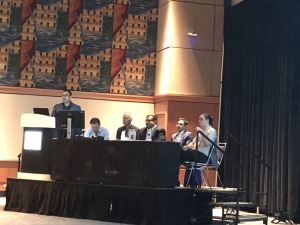by
Lisa Chamoff, Contributing Reporter | December 05, 2019
The adoption of artificial intelligence (AI) faces various challenges, from governance to how radiology residents learn about the technology.
A panel of experts brought up a number of ideas to address these challenges during a discussion of AI at the RSNA annual meeting, including creating public/private partnerships and promoting independent learning through video.
Dr. Mark Mullins, professor and vice chair of education at Emory Radiology, spoke about the importance of partnerships between private industry and academia to lead the adoption of AI.



Ad Statistics
Times Displayed: 45539
Times Visited: 1299 Ampronix, a Top Master Distributor for Sony Medical, provides Sales, Service & Exchanges for Sony Surgical Displays, Printers, & More. Rely on Us for Expert Support Tailored to Your Needs. Email info@ampronix.com or Call 949-273-8000 for Premier Pricing.
“I have seen many things develop in the absence of real-life experience and it isn’t quite as good,” Mullins said. “You need someone involved who knows where the applications are. In the big picture, this could give back a lot of time, effort and energy to practicing physicians.”
Janak Joshi, the senior vice president and chief technology officer of Life Image, a medical image and patient information sharing company, noted that part of the challenge of AI adoption is sorting through the explosion of AI providers, many of which offer similar solutions.
“I was roaming around the show floor downstairs in the AI pavilion and I counted about 28 companies who can do lung cancer detection of some sort,” Joshi said. “They all said that they were unique. They all trained their data probably on the data set coming from the National Cancer Institute. And each one of them said, ‘We are better than the other person.’ So how can 28 companies be different? Who here is saying that ‘I’m going to be the validation partner’ and ‘I’m going to be the one saying that every one of these guys is right’? So that’s part of the challenge for who should tackle this.”
Joshi agreed that a conglomerate of academics and industry, need to address AI, and he pointed to the CommonWell Health Alliance, a nonprofit trade association allows an exchange of patient data between various IT systems and facilities.
“We need the CommonWell of AI,” Joshi said.
Addressing resident education, Dr. George Shih, vice chair of informatics at Cornell Radiology and cofounder of MD.ai, a platform for medical AI, spoke about how to promote AI education to medical students via video.
“Who’s the best teacher in the world right now? YouTube,” Shih said. “If you want to watch the best deep learning video, you go to YouTube. I think kids learn in a different way today. … No one actually wants to listen to a traditional lecture anymore. Part of the issue we need to figure out is not only how do we incorporate AI, how are residents going to learn this information. I think it will be a lot more independent learning through video and computer interaction guided remotely by humans.”
Dr. Lindsey Shea, a radiology resident at Indiana University, spoke about the importance of collaboration through academic societies, but stressed that they needed to be wary about how patient populations vary in different areas.
“If we had a developed algorithm at our institution, it’s not necessarily going to be compatible with other institutions,” Shea said. “I think the idea of trying to do something more societally through RSNA or one of the larger organizations is an interesting one, but I think we also need to be cognizant of the differences in disease prevalence, different geographical locations, the different inherent populations that we have. There has been a lot of indication in the past that the AI can be biased toward whatever population it trained on. So it’s not something that we can take from one shop to another shop. I think each individual institution does have to have some buy-in.”

